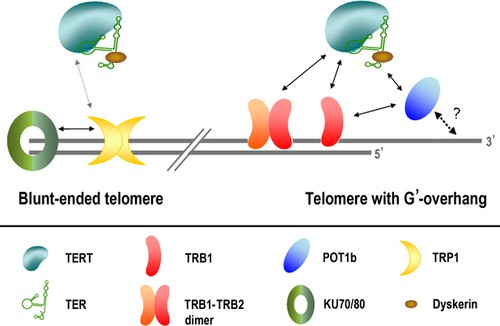Plant telomere binding protein (PTBP) is a protein that binds to plant telomeres, and its main function is to protect the telomeres from degradation and damage at the end of DNA and to participate in the maintenance of chromosome stability and the transmission of genetic information. Plant telomere binding protein mainly exists in the nucleus of plants and is highly conserved. The sequences and structures of PTBPs are slightly different in different plants, but they all have similar functions and mechanisms of action.
At Lifeasible, we possess a unique advantage in the regulatory analysis of plant telomere-binding proteins. Our team of highly skilled experts has an in-depth understanding of the molecular mechanisms and functional implications of these proteins.
| Domains | Proteins |
| Proteins containing the Myb domain | TRB1-3, TBP1, TRFL2-10 |
| CST complex protein | Stn1, TEN1, CTC1 |
 Fig. 1 Schematic diagram of observed protein-protein interactions at telomeric ends. (Schrumpfová PP, et al., 2014)
Fig. 1 Schematic diagram of observed protein-protein interactions at telomeric ends. (Schrumpfová PP, et al., 2014)
| Domains | Proteins | DNA binding sequence | Modulate telomerase activity | Modulate telomere length |
| OB | POT1 | Unknown | Positive/Negative/Unaffected/Unknown | Extension/Shorten/Unknown |
| RBD | STEP1 | (TTTAGGG)n | Negative | Shorten |
| Whirly | WHY1 | (TTTAGGG)n | Negative | Shorten |
| RRM | GTBP | (TTTAGGG)n | Unknown | Unknown |
With state-of-the-art laboratories and cutting-edge technologies, Lifeasible is equipped to perform comprehensive analyses of the regulatory role of plant telomere-binding proteins. If you are interested in our services or have some questions, please feel free to contact us or make an online inquiry.
Reference
Lifeasible has established a one-stop service platform for plants. In addition to obtaining customized solutions for plant genetic engineering, customers can also conduct follow-up analysis and research on plants through our analysis platform. The analytical services we provide include but are not limited to the following:
Why Do Plants Blush When They Are Hungry?
April 26, 2024
STU-CRISPR System Improves Plant Genome Editing Efficiency
April 19, 2024